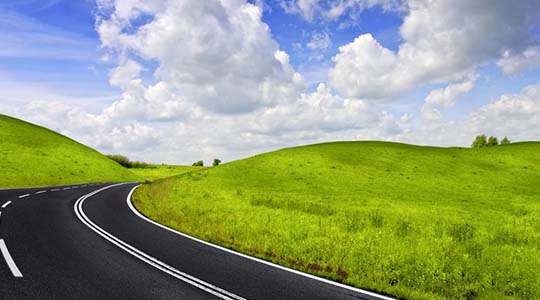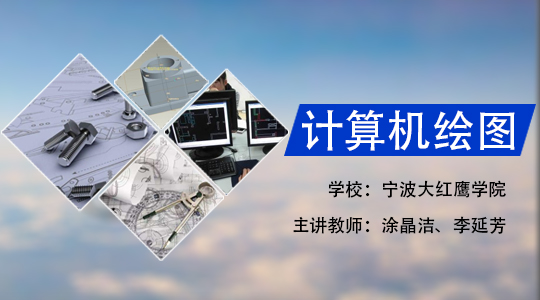
当前课程知识点:3ds Max: A Quick Start from Zero to One > Chapter 5: Basic Skills of Animation > 5.4.2 The Safeframe Cannot Be Ignored in the Camera > 5.4.2
返回《3ds Max: A Quick Start from Zero to One》慕课在线视频课程列表
返回《3ds Max: A Quick Start from Zero to One》慕课在线视频列表
摄像机里不能被忽略的安全框
制作影视动画时
我们有时会忽略摄像机的
一个非常重要的功能
安全框
今天
我们就来聊聊安全框
摄像机里不能被忽略的东西
一
安全框是啥
当你打设好摄像机
进行渲染时
可能会遇到一个奇怪的现象
渲染窗口显示的
图像和视口显示的效果
会有很大差距
这不是软件有问题
而是因为没有打开安全框
使用Shift+F键打开安全框
当视口出现土黄色线框
黑色遮挡区域时
再进行渲染
就会得到
与视口匹配的效果了
这一神奇的现象
就是安全框起到的作用
那么
安全框是什么呢
安全框等同于
摄像机的取景框
这个小框并不会被渲染出来
框里的画面就是
你最终要渲染输出的效果
二
安全框的附加功能
安全框除了帮助取景外
还有一个附加功能
就是作为参考线
为在电视播放的画面
提供剪裁参考依据
嗯
这如何理解呢
这么说吧
市场上有不同的显示设备
例如iPad
显示器
电视
对应着不同的尺寸
不同的分辨率和长宽比
把一段16:9的高清视频
放到上4:3的设备上播放
会因设备和编码的不同
呈现黑边的效果
如果在电视上播放
超出显示范围内的画面
就会被裁剪
所以
为了使画面不被裁剪
让后期字幕和特效制作
留有一定的安全距离
安全框就起到了
至关重要的参考作用
完整的安全框
呈现“回”字形
由三个方框组成
从内到外分别是
字幕安全区
动作安全区和用户安全区
中间土黄色的小方框
为字幕安全区
是字幕或特效画面的
取景范围
表示该区域外的画面
即使被裁减
安全区内的字幕和特效
也不会受到影响
绿色框为动作安全区
在该区域内
画面运动和构图是安全的
超出区域外的图像
在其他播放设备中
可能会被裁减
金黄色框为活动区域
在该区域内的
画面效果会被渲染输出
但要做好
有可能被裁剪的准备
三
如何打开附加功能
默认的安全框所显示的是
金黄色的用户安全区
属于标准版
需要通过设置
来打开它的附加功能
首先
找到视口左上角的+号
进入视口配置中的
安全框模块
其次
激活动作安全区和
标题安全区
最后
点击应用
查看视口效果
安全框的附加参考线
就显示出来了
好了
安全框的概念你已经懂了
记得做动画的时候要打开哦
能帮助你在后期
控制画面
获得更好的效果
-Fast Understand of 3ds Max,Starting Your Virtual Journey
--Preface
-Preface
-1.1 How to get 3ds Max
--1.1 02
-1.1
-1.2 Introduction to the Interface of 3ds Max
--1.2 01
--3ds Max
-1.2
-1.3.1 Project Preparation 1: Set Up Project Folder
--1.3.1
-1.3.1
-1.3.2 Project Preparation 2:Initialization Settings
--1.3.2
-1.3.2
-1.4.1 Opening and Saving Files
--1.4.1
-1.4.1
-1.4.2 Basics Operation
--1.4.2
-1.4.2
-1.4.3 Advanced Operation
--1.4.3
-1.4.3
-1.5 General Hotkeys
--1.5
-1.5
-1.6 Creating Geometric Primitives
--1.6
-1.6
-2.1 3D Modeling Overview
--2.1
-2.1
-2.2 Three Useful Modeling Methods
--2.2
-2.2
-2.3 Boolean Modeling
--2.3
-2.3
-2.4.1 Spline Modeling 1:Spline Modeling Overview
--2.4.1
-2.4.1
-2.4.2 Spline Modeling 2: Modeling From a Spline
--2.4.2
-2.4.2
-2.4.3 Spline Modeling 3:How to Edit Spline Objects
--2.4.3
-2.4.3
-2.5.1 Polygon Modeling 1:Polygon Modeling Method
--2.5.1
-2.5.1
-2.5.2 Component Selection Techniques
--2.5.2
-2.5.2
-2.5.3 Polygon Modeling 3: 16 Polygon Modeling Commands
--2.5.3
-2.5.3
-2.5.4 Polygon Modeling 4: Subdivision Modeling
--2.5.4
-2.5.4
-2.5.5 Polygon Modeling 5: Attaching and Detaching
--2.5.5
-2.5.5
-2.6.1 Advanced Modeling Skills 1:“Stereoscopic” Modeling Method
--2.6.1 01
-2.6.1
-2.6.2 Advanced Modeling Skills 2:Box Modeling Method
--2.6.2
-2.6.2
-2.6.3 Advanced Modeling Skills 3:Deconstruction Modeling Method
--2.6.3
-2.6.3
-2.6.4 Advanced Modeling Skills 4:Problems to be Considered in Modeling
--2.6.4
-2.6.4
-3.1 Rendering
--3.1 02
-3.1
-3.2.1 Render Your First Work
--3.2.1 02
-3.2.1
-3.2.2 Arnold Render Set Up
--3.2.2 01
-3.2.2
-3.2.3 Introduction to the Arnold Renderer
--3.2.3
-3.2.3
-3.2.4 Arnold Renderer 1: Sampling
--3.2.4 02
-3.2.4
-3.2.5 Arnold Renderer 2: RayDepth and Filtering
--3.2.5 02
-3.2.5
-3.3.1 What is Light?
--3.3.1 02
-3.3.1
-3.3.2 Light and Color
--3.3.2 02
-3.3.2
-3.3.3 Light and Shadow
--3.3.3 02
-3.3.3
-3.3.4 Produces Soft Shadows and Fast Shadow
--3.3.4 02
-3.3.4
-3.3.5 Six Types of Lighting
--3.3.5 01
-3.3.5
-3.4.1 Arnold Light Types
--3.4.1 01
-3.4.1
-3.4.2 Arnold Light Parameters
--3.4.2 01
-3.4.2
-3.4.3 Color Temperatures and White Balance
--3.4.3 01
-3.4.3
-3.5.1 Three-point Lighting Method
--3.5.1
-3.5.1
-3.5.2 Indoor Light Lecture 1: Make a Simple Night
--3.5.2
-3.5.2
-3.6.1 Advanced Skill 1:Rendering Tips
--3.6.1
-3.6.1
-3.6.2 Advanced Skill 2:The Normals and the Smooth Group
--3.6.2
-3.6.2
-4.1 Learn About This Chapter in Four Minutes
--4.1
-4.1
-4.2.1 How to Open the Material Editor?
--4.2.1
-4.2.1
-4.2.2 Using Physical Materials
--4.2.2
-4.2.2
-4.2.3 Three Assistants of the Material
--4.2.3
-4.2.3
-4.2.4 Create a Simple Material
--4.2.4
-4.2.4
-4.3.1 Using maps to Creat Different Looking
--4.3.1
-4.3.1
-4.3.2 Bitmap Node:A Small Node With Virtues
--4.3.2
-4.3.2
-4.4.1 UVW Mapping Method 1:Methods of Locking the Map
--4.4.1
-4.4.1
-4.4.2 UVW Mapping Method 2: UV Overlays
--4.4.2
-4.4.2
-4.4.3 Unwrap UVW 1: Basic of Unwrap UVW Modifier
--4.4.3
-4.4.3
-4.4.4 Unwrap UVW 2: Projection
--4.4.4
-4.4.4
-4.4.5 Unwrap UVW Part 3: Powerful UV Editor
--4.4.5
-4.4.5
-5.1 Animation Overvie
--5.1
-5.1
-5.2.1 3ds Max Animation
--5.2.1
-5.2.1
-5.2.2 Making Animation More Interesting Principle 1: Time and Space
--5.2.2
-5.2.2
-5.2.3 Making Animation More Interesting Principle 2: Slow Motion (slow-mo)
--5.2.3
-5.2.3
-5.2.4 Making Animation More Interesting Principle 3: Squash and Stretch
--5.2.4
-5.2.4
-5.3.1 Animation Technique 1: Parent-Child Relationship
--5.3.1
-5.3.1
-5.3.2 Animation Technique 2:Loop Animation
--5.3.2
-5.3.2
-5.4.1 Techniques of Using the Camera
--5.4.1
-5.4.1
-5.4.2 The Safeframe Cannot Be Ignored in the Camera
--5.4.2
-5.4.2
-5.4.3 Camera Movement
--5.4.3
-5.4.3
-5.4.4 Following Shot
--5.4.4
-5.4.4
-6.1 Rendering a VR Panorama With Arnold
--6.1
-6.1
-6.2 Fast Implementation of VR Interaction
--6.2
-6.2
-6.3 Fast Implementation of AR Interaction
--6.3
-6.3
-6.4 Friends of 3ds Max
--6.4
-6.4
-6.5 Self Learning and Improvement Methods
--6.5
-6.5
-6.6 Methods of Obtaining Resources
--6.6
-6.6
-7.1 PBR Technology Introduction
--7.1
-7.2 Toolbag PBR Real-time Rendering
--7.2
-7.3 Substance Painter PBR Painting
--7.3
-Shortfilm Casestudy 1:The Weapon Used in PUBG (PlayerUnknown's Battlegrounds)
--Microfilm Course 1:The Weapon Used in Eating Chicken
-Shortfilm Casestudy 2:Production experience of Classic of Mountains and Seas
--Microfilm Course 2:Production Process of Shanhaijing
-Examination



